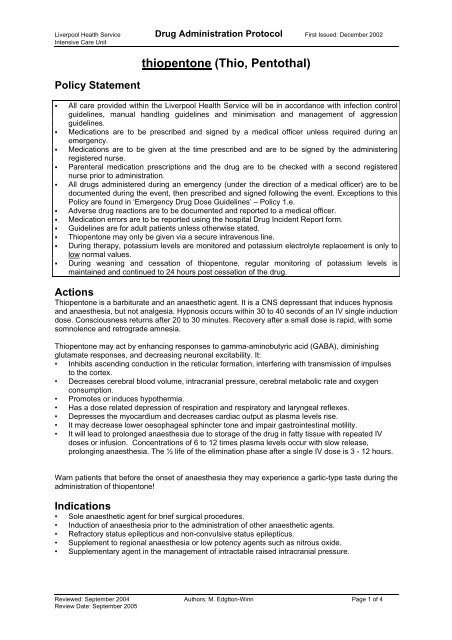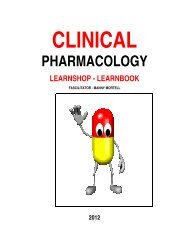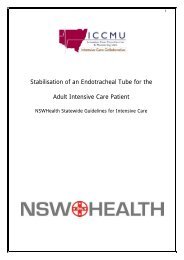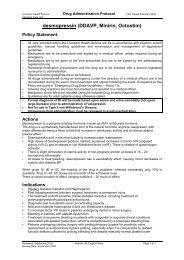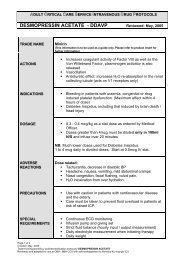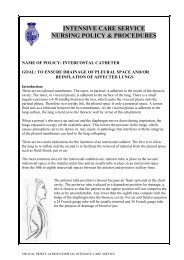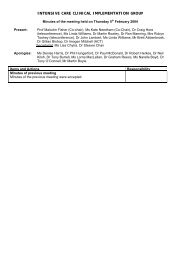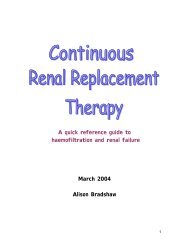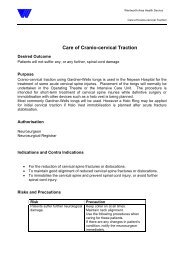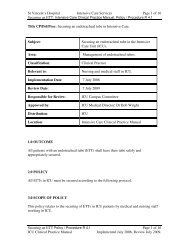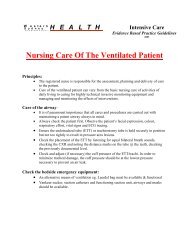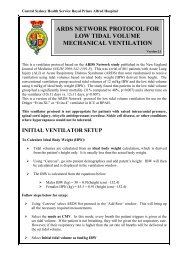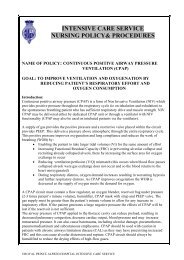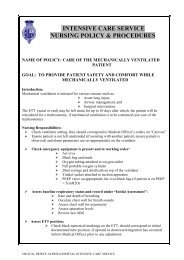thiopentone - Intensive Care & Coordination Monitoring Unit
thiopentone - Intensive Care & Coordination Monitoring Unit
thiopentone - Intensive Care & Coordination Monitoring Unit
Create successful ePaper yourself
Turn your PDF publications into a flip-book with our unique Google optimized e-Paper software.
Liverpool Health Service Drug Administration Protocol First Issued: December 2002<br />
<strong>Intensive</strong> <strong>Care</strong> <strong>Unit</strong><br />
Policy Statement<br />
<strong>thiopentone</strong> (Thio, Pentothal)<br />
• All care provided within the Liverpool Health Service will be in accordance with infection control<br />
guidelines, manual handling guidelines and minimisation and management of aggression<br />
guidelines.<br />
• Medications are to be prescribed and signed by a medical officer unless required during an<br />
emergency.<br />
• Medications are to be given at the time prescribed and are to be signed by the administering<br />
registered nurse.<br />
• Parenteral medication prescriptions and the drug are to be checked with a second registered<br />
nurse prior to administration.<br />
• All drugs administered during an emergency (under the direction of a medical officer) are to be<br />
documented during the event, then prescribed and signed following the event. Exceptions to this<br />
Policy are found in ‘Emergency Drug Dose Guidelines’ – Policy 1.e.<br />
• Adverse drug reactions are to be documented and reported to a medical officer.<br />
• Medication errors are to be reported using the hospital Drug Incident Report form.<br />
• Guidelines are for adult patients unless otherwise stated.<br />
• Thiopentone may only be given via a secure intravenous line.<br />
• During therapy, potassium levels are monitored and potassium electrolyte replacement is only to<br />
low normal values.<br />
• During weaning and cessation of <strong>thiopentone</strong>, regular monitoring of potassium levels is<br />
maintained and continued to 24 hours post cessation of the drug.<br />
Actions<br />
Thiopentone is a barbiturate and an anaesthetic agent. It is a CNS depressant that induces hypnosis<br />
and anaesthesia, but not analgesia. Hypnosis occurs within 30 to 40 seconds of an IV single induction<br />
dose. Consciousness returns after 20 to 30 minutes. Recovery after a small dose is rapid, with some<br />
somnolence and retrograde amnesia.<br />
Thiopentone may act by enhancing responses to gamma-aminobutyric acid (GABA), diminishing<br />
glutamate responses, and decreasing neuronal excitability. It:<br />
• Inhibits ascending conduction in the reticular formation, interfering with transmission of impulses<br />
to the cortex.<br />
• Decreases cerebral blood volume, intracranial pressure, cerebral metabolic rate and oxygen<br />
consumption.<br />
• Promotes or induces hypothermia.<br />
• Has a dose related depression of respiration and respiratory and laryngeal reflexes.<br />
• Depresses the myocardium and decreases cardiac output as plasma levels rise.<br />
• It may decrease lower oesophageal sphincter tone and impair gastrointestinal motility.<br />
• It will lead to prolonged anaesthesia due to storage of the drug in fatty tissue with repeated IV<br />
doses or infusion. Concentrations of 6 to 12 times plasma levels occur with slow release,<br />
prolonging anaesthesia. The ½ life of the elimination phase after a single IV dose is 3 - 12 hours.<br />
Warn patients that before the onset of anaesthesia they may experience a garlic-type taste during the<br />
administration of <strong>thiopentone</strong>!<br />
Indications<br />
• Sole anaesthetic agent for brief surgical procedures.<br />
• Induction of anaesthesia prior to the administration of other anaesthetic agents.<br />
• Refractory status epilepticus and non-convulsive status epilepticus.<br />
• Supplement to regional anaesthesia or low potency agents such as nitrous oxide.<br />
• Supplementary agent in the management of intractable raised intracranial pressure.<br />
Reviewed: September 2004 Authors: M. Edgtton-Winn Page 1 of 4<br />
Review Date: September 2005
Liverpool Health Service Drug Administration Protocol First Issued: December 2002<br />
<strong>Intensive</strong> <strong>Care</strong> <strong>Unit</strong><br />
Contraindications<br />
• Known hypersensitivity to <strong>thiopentone</strong> and other barbiturates.<br />
• Complete absence of suitable veins.<br />
• Threatened airway and upper airway obstruction.<br />
• Variegate or acute intermittent porphyria.<br />
• Constrictive pericarditis, severe cardiovascular disease.<br />
• Uncorrected hypovolaemia, hypotension or shock.<br />
• Addison's disease, myxoedema, myasthenia gravis.<br />
• Hepatic or renal dysfunction, increased blood urea.<br />
• Severe anaemia.<br />
Precautions<br />
• Potassium disturbances – measure levels regularly.<br />
• Keep resuscitative and endotracheal intubation equipment and oxygen readily available.<br />
• Avoid extravasation or intra-arterial injection.<br />
• There is an increased risk of paracetamol toxicity and thus hepatotoxicity (secondary to enzyme<br />
induction) when a patient receives paracetamol in conjunction with large doses of <strong>thiopentone</strong>.<br />
Significant Interactions<br />
• Probenecid prolongs the action of <strong>thiopentone</strong>.<br />
• Benzodiazepines have a synergistic action when used with <strong>thiopentone</strong>.<br />
• Ethanol increases the CNS depressant effects of <strong>thiopentone</strong> and ethanol and diazepam increase<br />
its hypotensive effects.<br />
• Rapid or high doses of ketamine will increase the incidence of hypotension and respiratory<br />
depression.<br />
• Magnesium sulphate IV increases CNS depressant effects.<br />
• Phenothiazines potentiate hypotensive and CNS excitatory effects.<br />
• Aminophylline antagonizes <strong>thiopentone</strong>.<br />
• Thiopentone is incompatible in solution with many drugs – flush well and use a dedicated line for<br />
infusions.<br />
Adverse Effects<br />
• Hypotension, tachycardia.<br />
• Respiratory depression, apnoea.<br />
• Myocardial depression, reduced cardiac output.<br />
• Bronchospasm, laryngospasm.<br />
• Hypersensitivity reactions – sneezing, pruritus.<br />
• Tissue necrosis with extravasation.<br />
• Shivering (increased sensitivity to cold) and hypothermia.<br />
• Inadequate T lymphocyte function, leading to iatrogenic infections (in large doses, prolonged<br />
infusions).<br />
• Excitatory phenomena - involuntary muscle movements, coughing, hiccups have been reported.<br />
Presentation<br />
Thiopentone 500mg ampoule (powder) with 20mL sterile water ampoule for reconstitution.<br />
Administration Guidelines<br />
• Thiopentone is administered by the intravenous route only.<br />
• Individual response to the drug is so varied that there can be no fixed dosage.<br />
• Younger patients require relatively larger doses than middle aged and elderly people; the latter<br />
metabolise the drug more slowly.<br />
• Prepuberty requirements are the same for both sexes, women require less than men.<br />
• Dose is usually proportional to bodyweight and for infusions: obese patients require a larger dose<br />
than relatively lean people of the same weight.<br />
• For induction, the dosage is calculated on the lean body mass.<br />
• Discard cloudy solutions or solutions showing a precipitate.<br />
• Patients receiving <strong>thiopentone</strong> for the management of raised intracranial pressure should have<br />
continuous EEG monitoring where available.<br />
Reviewed: September 2004 Authors: M. Edgtton-Winn Page 2 of 4<br />
Review Date: September 2005
Liverpool Health Service Drug Administration Protocol First Issued: December 2002<br />
<strong>Intensive</strong> <strong>Care</strong> <strong>Unit</strong><br />
Administration Guidelines<br />
Induction of anaesthesia: via secure IV line<br />
Dilute 500mg <strong>thiopentone</strong> with 20mL sterile water to arrive at a concentration of 25mg/mL<br />
• Bolus 100 – 250mg (4 to 10mL) or 3 – 5mg/kg injected over 10-20 seconds.<br />
• Flush the line well, post administration.<br />
• Observe blood pressure and need for administration of a volume expander.<br />
• Once anaesthesia is established, additional bolus injections of 25 - 50mg (1 to 2mL) can be given<br />
according to patient needs.<br />
The tone of jaw muscles is a fairly reliable index for achieving anaesthesia. Corneal and conjunctival<br />
reflexes disappear.<br />
Management of convulsive states: via secure Central Venous access<br />
Dilute 2 grams of <strong>thiopentone</strong> with 50mL sterile water for injection to give a concentration of<br />
40mg/mL.<br />
Administer 1 – 3mg/kg and repeat as necessary<br />
Infusion Loading Dose:<br />
Dilute 2 grams of <strong>thiopentone</strong> with 50mL sterile water for injection to give a concentration of<br />
40mg/mL.<br />
Administer 3mg/kg bolus.<br />
Infusion to cease seizure activity:<br />
Titrate an infusion of 2 grams <strong>thiopentone</strong> in 50mL sterile water for injection, to control EEG<br />
monitored seizure activity.<br />
Management of Raised Intracranial Pressure: via secure Central Venous access<br />
Dilute 2 grams of <strong>thiopentone</strong> with 50mL sterile water for injection to give a concentration of<br />
40mg/mL.<br />
1. Loading Dose:<br />
• Administer a loading dose of between 500mg – 2 grams <strong>thiopentone</strong> over 1 hour<br />
2. Infusion to achieve burst suppression:<br />
• Infuse 10mg/kg for up to six hours to achieve burst suppression.<br />
• A smaller or greater volume of drug may be required due to individual response and<br />
differences in fat deposit uptake of the drug.<br />
• When EEG monitoring is utilised, a burst: suppression ratio is prescribed. This is generally<br />
1:1 or 1:2 burst: suppression – indicating absence of brain waves (resting of the cell) with<br />
allowance for some electrical breakthrough.<br />
• When burst suppression of 1:2 (a 6-second burst of electrical activity followed by a 12-second<br />
interval of electrical silence) is achieved, commence a maintenance regime of 3mg/kg/hr.<br />
• In the absence of dual channel EEG monitoring, the dose of <strong>thiopentone</strong> may be reduced in<br />
order to avoid over-administration and EEG electrical silence.<br />
3. Infusion for maintenance of required burst suppression ratio:<br />
• A maintenance regime is commenced at 3 - 5mg <strong>thiopentone</strong>/kg/hr.<br />
• This may need to be altered to suit the individual patient and achieve the required<br />
burst:suppression ratio.<br />
• Therapeutic serum level: 6 – 8.5 mg/dL.<br />
I f access is by peripheral line, the strength of the solution must be further diluted<br />
Reviewed: September 2004 Authors: M. Edgtton-Winn Page 3 of 4<br />
Review Date: September 2005
Liverpool Health Service Drug Administration Protocol First Issued: December 2002<br />
<strong>Intensive</strong> <strong>Care</strong> <strong>Unit</strong><br />
(1 gram in 50mL sterile water, 20mg/mL) and highlighted to both medical and nursing staff.<br />
Clinical Considerations<br />
• Patients receiving <strong>thiopentone</strong> infusions are to receive vigilant attention to all aspects of infection<br />
control due to their increased susceptibility to opportunistic infection.<br />
• Patients receiving prolonged infusions should be nursed away from patients with MRSA and other<br />
infections that may be spread by droplet or hand contact.<br />
• Thiopentone does not have analgesic properties.<br />
• Daily serum levels are required to assess for a return of possible consciousness/responsiveness.<br />
A zero level is required before responsiveness is likely.<br />
• For patients receiving large doses of <strong>thiopentone</strong>, concomitant use of paracetamol must be<br />
regulated and liver enzymes assessed regularly.<br />
• Potassium levels are known to fall with <strong>thiopentone</strong> infusions. Replace to a low-normal value.<br />
• Use caution when weaning or ceasing infusions as rebound hyperkalaemia may result.<br />
• Always monitor potassium levels regularly during weaning and for 24 hours post cessation of<br />
drug therapy.<br />
References<br />
Carlton, J.B. 1997. The handbook of parenteral drug administration. (4<br />
th . Ed.). William’s Printers. Shepparton<br />
MIMS Online. CIAP: NSW Health Department. 1 May 2002 - 31 July 2002. http://www.mims.hcn.net.au/<br />
Krier, C. et al 1984 Hazards of high dose barbiturate therapy in head injured patients. Acta Anaesthesiolo gie Belgique. 35: 361<br />
– 365.<br />
Piatt, J. et al 1984 High dose barbiturate therapy in neurosurgery and intensive care. Neurosurgery. 15. (3): 427- 441.<br />
Megilli, C. 1985 Cerebral protection, pathophysiology and treatment of intracranial pressure. Chest. 87. (1): 85-93<br />
Mirr at al. 1983 Nursing management for barbiturate therapy in acute head injury. Heart and Lung. 12. (1): 52<br />
Stover, J.P. et al. 1998 Thiopental in CSF and serum correlates with prolonged loss of cortical activity. European Neurologique.<br />
39. (4):223-228.<br />
Nadal, P. et al. 1995 Pneumonia in ventilated head trauma patients: the role of thiopental therapy. European Journal of<br />
Emergency Medicine. 2.(1): 14-16.<br />
Roberts, I. Barbiturates in the management of severe brain injury. (Cochrane Review) In: The Cochrane Library, Issue 2.<br />
Oxford: Update Software; 1998. Updated quarterly.<br />
Schwab, S. et al. 1997 Barbiturate coma in severe h emispheric stroke: useful or obsolete? Neurology. 48. (6): 1608-1613<br />
Toyama, T. 2001 Anaesthesia and critical care: Barbiturate coma. http://www.trauma.org/anaesthesia/barbcoma.html<br />
Cairns, C., Thomas, B., Fletcher, S., Parr, M. and Finfer, S. 2002 Life threatening hyperkalaemia following therapeutic<br />
barbiturate come. <strong>Intensive</strong> <strong>Care</strong> Medicine 28:1357-1360.<br />
Policy Author(s)<br />
Policy Reviewers:<br />
M. Edgtton-Winn, ICU – CNC, and see “Pharmacology Acknowledgements.doc”<br />
ICU Director, ICU – CNC.<br />
Reviewed: September 2004 Authors: M. Edgtton-Winn Page 4 of 4<br />
Review Date: September 2005


